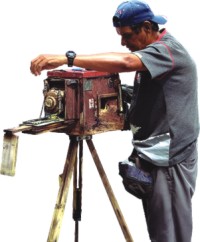| Spotlight
Brief History of Camera
 The first permanent photograph was made in 1826 or 1827 by Joseph Nicéphore Niépce using a sliding wooden box camera made by Charles and Vincent Chevalier in Paris. Niépce built on a discovery by Johann Heinrich Schultz (1724): a silver and chalk mixture darkens under exposure to light. While this was the introduction of photography, the history of the camera itself can be traced back much further. Photographic cameras were a development of the camera obscura, a device dating back to the Book of Optics (1021) of the Iraqi Arab scientist Ibn al-Haytham (Alhacen),[1] which uses a pinhole or lens to project an image of the scene outside onto a viewing surface. The first permanent photograph was made in 1826 or 1827 by Joseph Nicéphore Niépce using a sliding wooden box camera made by Charles and Vincent Chevalier in Paris. Niépce built on a discovery by Johann Heinrich Schultz (1724): a silver and chalk mixture darkens under exposure to light. While this was the introduction of photography, the history of the camera itself can be traced back much further. Photographic cameras were a development of the camera obscura, a device dating back to the Book of Optics (1021) of the Iraqi Arab scientist Ibn al-Haytham (Alhacen),[1] which uses a pinhole or lens to project an image of the scene outside onto a viewing surface.
Before the invention of photographic lapel processes, there was no way to preserve the images produced by these cameras apart from manually tracing them. The earliest cameras were room-sized, with space for one or more people inside; these gradually evolved into more and more compact models such that by Niépce's time portable handheld cameras suitable for photography were readily available. The first camera that was small and portable enough to be practical for photography was built by Johann Zahn in 1685, though it would be almost 150 years before such an application was possible.
First exposure
Joseph Nicéphore Niépce took the first photograph by coating a pewter plate with bitumen and exposing the plate to light. The bitumen hardened where light struck. The unhardened areas were then dissolved home and away.
Daguerreotypes and calotypes
Louis Jacques Daguerre and Joseph Nicéphore Niépce (who was Daguerre's partner, but died before their invention was completed) invented the first practical photographic method, which was named the daguerreotype, in 1836. Daguerre coated a copper plate with silver, then treated it with iodine vapour to make it sensitive to light. The image was developed by mercury vapor and fixed with a strong solution of ordinary salt. William Fox Talbot perfected a different process, the calotype, in 1840. Both used cameras that were little different from Zahn's model, with a sensitized plate or sheet of paper placed in front of the viewing screen to record the image. Focusing was generally via sliding boxes.
Dry plates
19th century studio camera
Collusion dry plates had been available since 1855, thanks to the work of Désiré van Monckhoven, but it was not until the invention of the gelatine dry plate in 1871 by Richard Leach Maddox that they rivaled wet plates in speed and quality. The advantages of the dry plate were obvious: photographers could use commercial dry plates off the shelf instead of having to prepare their own emulsions in a mobile darkroom. Also, for the first time, cameras could be made small enough to be hand-held, or even concealed. There was a proliferation of various designs, from single- and twin-lens reflexes to large and bulky field cameras, handheld cameras, and even cameras disguised as pocket watches, hats, or other objects.
The shortened exposure times that made candid photography possible also necessitated another innovation, the mechanical shutter. The very first shutters were separate accessories, though built-in shutters were common by the turn of the century.
Kodak and the birth of film
Kodak No. 2 Brownie box camera, circa 1910
The use of photographic film was pioneered by George Eastman, who started manufacturing paper film in 1885 before switching to celluloid in 1889. His first camera, which he called the "Kodak," was first offered for sale in 1888. It was a very simple box camera with a fixed-focus lens and single shutter speed, which along with its relatively low price appealed to the average consumer. The Kodak came pre-loaded with enough film for 100 exposures and needed to be sent back to the factory for processing and reloading when the roll was finished. By the end of the 19th century Eastman had expanded his lineup to several models including both box and folding cameras.
In 1900, Eastman took mass-market photography one step further with the Brownie, a simple and very inexpensive box camera that introduced the concept of the snapshot. The Brownie was extremely popular and various models remained on sale until the 1960s.
Source: Internet
Copyright
(R) thedailystar.net 2008 |

